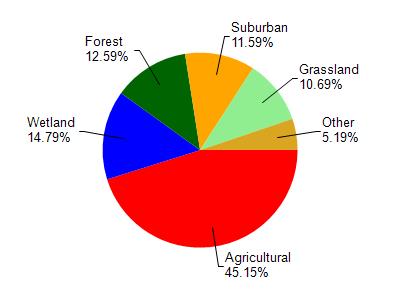Kenosha
No
No
No
Fish and Aquatic Life
Overview
This warm water seepage lake lies on the Illinois-Wisconsin state line. It can be considered the headwaters of Trevor Creek. A drop inlet type control structure on its outlet maintains 3.0 ft. of head. Outlet water is confined to an underground culvert for several hundred feet to a roadside ditch where it becomes an open stream. This lake is managed for largemouth bass and panfish, but northern pike are also present. Since public access is not adequate, meaningful management is not possible. The lake association in Wisconsin received DNR approval to stock largemouth bass and northern pike in the early 1970s. Although it is one of the deeper lakes in Kenosha County, aquatic vegetation is a persistent problem in the littoral areas.
Source: 1982, Surface Water Resources of Kenosha County Cross Lake, TlN, R20E, Section 35, 36 Surface Acres = 87 acres, Maximum Depth = 35 ft, Secchi disc = 6.5 ft.
Date 1982
Author Aquatic Biologist
Condition
Wisconsin has over 84,000 miles of streams, 15,000 lakes and milllions of acres of wetlands. Assessing the condition of this vast amount of water is challenging. The state's water monitoring program uses a media-based, cross-program approach to analyze water condition. An updated monitoring strategy (2015-2020) is now available. Compliance with Clean Water Act fishable, swimmable standards are located in the Executive Summary of Water Condition in 2018. See also the 'monitoring and projects' tab.
Reports
Management Goals
Wisconsin's Water Quality Standards provide qualitative and quantitative goals for waters that are protective of Fishable, Swimmable conditions [Learn more]. Waters that do not meet water quality standards are considered impaired and restoration actions are planned and carried out until the water is once again fishable and swimmable
Management goals can include creation or implementation of a Total Maximum Daily Load analysis, a Nine Key Element Plan, or other restoration work, education and outreach and more. If specific recommendations exist for this water, they will be displayed below online.
Monitoring
Monitoring the condition of a river, stream, or lake includes gathering physical, chemical, biological, and habitat data. Comprehensive studies often gather all these parameters in great detail, while lighter assessment events will involve sampling physical, chemical and biological data such as macroinvertebrates. Aquatic macroinvertebrates and fish communities integrate watershed or catchment condition, providing great insight into overall ecosystem health. Chemical and habitat parameters tell researchers more about human induced problems including contaminated runoff, point source dischargers, or habitat issues that foster or limit the potential of aquatic communities to thrive in a given area. Wisconsin's Water Monitoring Strategy was recenty updated.
Grants and Management Projects
| Project Name (Click for Details) | Year Started |
|---|
|
|
Monitoring Projects
| WBIC | Official Waterbody Name | Station ID | Station Name | Earliest Fieldwork Date | Latest Fieldwork Date | View Station | View Data |
|---|
| 746500 | Cross Lake | 303127 | Cross Lake - Deep Hole | 6/14/1989 | 8/30/2025 | Map | Data |
| 746500 | Cross Lake | 10047364 | Cross Lake -- CE Peks Subdivision Parkway Property Boat Launch | 5/10/2011 | 5/12/2023 | Map | Data |
| 746500 | Cross Lake | 10003097 | Cross Lake | 8/2/1967 | 9/20/2024 | Map | Data |
|

Watershed Characteristics
Cross Lake is located in the Lower Fox River - Illinois watershed which is 114.04 mi². Land use in the watershed is primarily agricultural (45.20%), wetland (14.80%) and a mix of forest (12.60%) and other uses (27.50%). This watershed has 144.75 stream miles, 2,176.46 lake acres and 9,772.38 wetland acres.
Nonpoint Source Characteristics
This watershed is ranked Medium for runoff impacts on streams, Medium for runoff impacts on lakes and High for runoff impacts on groundwater and therefore has an overall rank of High. This value can be used in ranking the watershed or individual waterbodies for grant funding under state and county programs.However, all waters are affected by diffuse pollutant sources regardless of initial water quality. Applications for specific runoff projects under state or county grant programs may be pursued. For more information, go to surface water program grants.